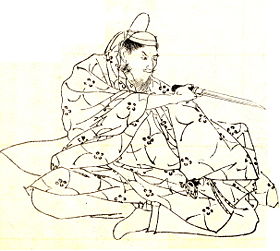
Taira no Tadamori
Encyclopedia

was a Taira clan
Taira clan
The was a major Japanese clan of samurai in historical Japan.In reference to Japanese history, along with Minamoto, Taira was a hereditary clan name bestowed by the emperors of the Heian Period to certain ex-members of the imperial family when they became subjects...
samurai
Samurai
is the term for the military nobility of pre-industrial Japan. According to translator William Scott Wilson: "In Chinese, the character 侍 was originally a verb meaning to wait upon or accompany a person in the upper ranks of society, and this is also true of the original term in Japanese, saburau...
, father of Taira no Kiyomori
Taira no Kiyomori
was a general of the late Heian period of Japan. He established the first samurai-dominated administrative government in the history of Japan.After the death of his father Taira no Tadamori in 1153, Kiyomori assumed control of the Taira clan and ambitiously entered the political realm in which he...
, and member of the Kebiishi (Imperial police force). Tadamori was also governor
Governor
A governor is a governing official, usually the executive of a non-sovereign level of government, ranking under the head of state...
of the provinces of Harima
Harima Province
or Banshu was a province of Japan in the part of Honshū that is the southwestern part of present-day Hyōgo Prefecture. Harima bordered on Tajima, Tamba, Settsu, Bizen, and Mimasaka Provinces. Its capital was Himeji....
, Ise
Ise Province
or was a province of Japan including most of modern Mie Prefecture. Ise bordered Iga, Kii, Mino, Ōmi, Owari, Shima, and Yamato Provinces.The ancient provincial capital was at Suzuka...
, Bizen
Bizen Province
was a province of Japan on the Inland Sea side of Honshū, in what is today the southeastern part of Okayama Prefecture. It was sometimes called , with Bitchu and Bingo Provinces. Bizen borders Mimasaka, Harima, and Bitchū Provinces....
, and Tajima
Tajima Province
was an old province of Japan in the area that is today northern Hyōgo Prefecture. It was sometimes called . Tajima bordered on Harima, Inaba, Tamba, and Tango provinces....
.
He consolidated the influence of the Taira clan at the Imperial Court, and is said to have been the first samurai to serve the Emperor directly, at Court.
As a servant of the Court, Tadamori waged campaigns, beginning in 1129, against pirates
Wokou
Wokou , which literally translates as "Japanese pirates" in English, were pirates of varying origins who raided the coastlines of China and Korea from the 13th century onwards...
on the coasts of San'yōdō
San'yodo
is a Japanese term denoting both an ancient division of the country and the main road running through it. The San'yōdō corresponds for the most part with the modern conception of the San'yō region,San'yō translates to "the sunlight-side of a mountain", while dō, depending on the context, can mean...
and Nankaidō
Nankaido
The , literally meaning "southern sea road," is a Japanese term denoting both an ancient division of the country and the main road running through it. The road connected provincial capitals in this region...
(two of the Gokishichidō
Gokishichido
was the name for ancient administrative units organized in Japan during the Asuka Period , as part of a legal and governmental system borrowed from the Chinese...
, large administrative divisions of Japan). He also served his own clan in battling the warrior monks
Sohei
were Buddhist warrior monks of feudal Japan. At certain points of history they held considerable power, obliging the imperial and military governments to collaborate....
of Nara
Nara, Nara
is the capital city of Nara Prefecture in the Kansai region of Japan. The city occupies the northern part of Nara Prefecture, directly bordering Kyoto Prefecture...
and of Mount Hiei
Mount Hiei
is a mountain to the northeast of Kyoto, lying on the border between the Kyoto and Shiga prefectures, Japan.The temple of Enryaku-ji, the first outpost of the Japanese Tiantai sect of Buddhism, was founded atop Mount Hiei by Saichō in 788. Both Nichiren and Honen studied at the temple before...
.
Tadamori is also credited with the construction of the Rengeō-in, a major and now-famous temple in Kyoto, which includes the longest wooden building in the world, the Sanjūsangen-dō
Sanjusangen-do
is a Buddhist temple in Higashiyama District of Kyoto, Japan. Officially known as "Rengeō-in" , or Hall of the Lotus King, Sanjūsangen-dō belongs to and is run by the Myoho-in temple, a part of the Tendai school of Buddhism. The temple name literally means Hall with thirty three spaces between...
. Tadamori was granted the governorship of Tajima province as a reward for completing this project.

